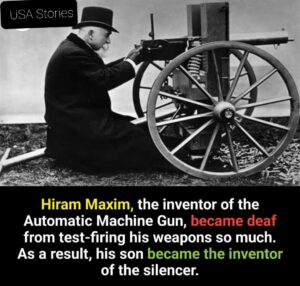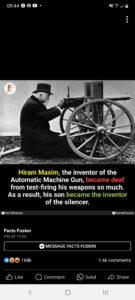
Maxim harnessed a bullet’s recoil power to create a portable machine gun needed only one barrel to fire all of its bullets automatically. A gun based on his design became standard issue for the British Army during World War I, which became known as “the machine gun war.”
A Knack for Invention
In 1884, Hiram Maxim built the first effective machine gun, which revolutionized warfare. Born in 1840 in Sangersville, Maine, Maxim was apprenticed at 14 to a carriage maker. While learning that trade, he exhibited a knack for invention, designing a mousetrap that automatically reset and rid local mills of rodents. He obtained the first of his 271 patents at age 26 for a curling iron. By his 30s, Maxim was becoming chief engineer of the United States Electric Lighting Co. in New York, for which he introduced carbon filaments for electric light bulbs. At the 1881 Paris Exhibition, he demonstrated an electric pressure regulator and was awarded the Legion d’Honneur. That same year he arrived in England to reorganize the London offices of U.S. Electric Lighting Company. There he began work on his machine gun.
The Power of Recoil
Its precursor, the Gatling gun, was a hand-driven, crank-operated gun with first six, later ten, barrels and a maximum fire rate of 1,200 rounds per minute. A magazine mounted on top of the gun fed bullets via gravity. Maxim’s innovation was to harness the recoil power of each bullet, a force strong enough to eject the used cartridge and draw in the next one. Structured in this way, the portable gun needed only one barrel to fire all of its bullets automatically. To maximize the gun’s effectiveness, Maxim also developed his own smokeless powder, cordite. In 1884, he founded the Maxim Gun Company in Britain to produce his new weapon. Five years later, he licensed it to the British Army in 1889; the following year the Austrian, German, Italian, Swiss, and Russian armies also incorporated it into their firearm auxiliary.
The Machine Gun War
In 1896, the Maxim Gun Company was bought out by Vickers Ltd., of which Maxim became a director. The Vickers machine gun would become standard issue of the British Army during World War I, which became known as “the machine gun war.” The gun’s destructive abilities necessitated trench warfare as a defensive strategy.
Legacy of Death
Later in life, Maxim turned his attention from warfare to flight, building a steam engine-powered airplane that briefly rose from the ground. While he was unable to achieve sustained flight, his amusement ride, the Captive Flying Machine, became a staple of British fairgrounds. Maxim died on November 24, 1916, only days before the Battle of the Somme, where over one million soldiers fell in four months of machine gun warfare.

Leave a Reply